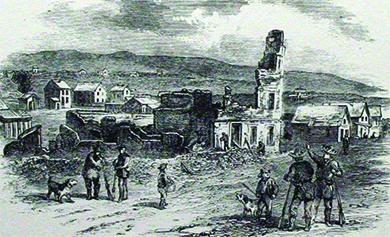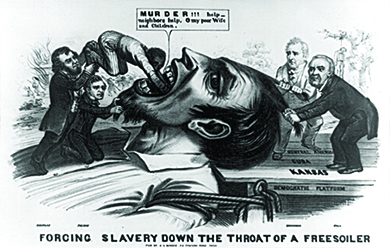| << Chapter < Page | Chapter >> Page > |
Brown’s actions precipitated a new wave of violence. All told, the guerilla warfare between proslavery “border ruffians” and antislavery forces, which would continue and even escalate during the Civil War, resulted in over 150 deaths and significant property loss. The events in Kansas served as an extreme reply to Douglas’s proposition of popular sovereignty. As the violent clashes increased, Kansas became known as “ Bleeding Kansas .” Antislavery advocates’ use of force carved out a new direction for some who opposed slavery. Distancing themselves from William Lloyd Garrison and other pacifists, Brown and fellow abolitionists believed the time had come to fight slavery with violence.

The violent hostilities associated with Bleeding Kansas were not limited to Kansas itself. It was the controversy over Kansas that prompted the caning of Charles Sumner, introduced at the beginning of this chapter with the political cartoon Southern Chivalry: Argument versus Club’s ( [link] ). Note the title of the cartoon; it lampoons the southern ideal of chivalry, the code of behavior that Preston Brooks believed he was following in his attack on Sumner. In Sumner’s “Crime against Kansas” speech he went much further than politics, filling his verbal attack with allusions to sexuality by singling out fellow senator Andrew Butler from South Carolina, a zealous supporter of slavery and Brooks’s uncle. Sumner insulted Butler by comparing slavery to prostitution, declaring, “Of course he [Butler] has chosen a mistress to whom he has made his vows, and who, though ugly to others, is always lovely to him; though polluted in the sight of the world, is chaste in his sight. I mean the harlot Slavery.” Because Butler was aged, it was his nephew, Brooks, who sought satisfaction for Sumner’s attack on his family and southern honor. Brooks did not challenge Sumner to a duel; by choosing to beat him with a cane instead, he made it clear that he did not consider Sumner a gentleman. Many in the South rejoiced over Brooks’s defense of slavery, southern society, and family honor, sending him hundreds of canes to replace the one he had broken assaulting Sumner. The attack by Brooks left Sumner incapacitated physically and mentally for a long period of time. Despite his injuries, the people of Massachusetts reelected him.
The electoral contest in 1856 took place in a transformed political landscape. A third political party appeared: the anti-immigrant American Party , a formerly secretive organization with the nickname “the Know-Nothing Party” because its members denied knowing anything about it. By 1856, the American or Know-Nothing Party had evolved into a national force committed to halting further immigration. Its members were especially opposed to the immigration of Irish Catholics, whose loyalty to the Pope, they believed, precluded their loyalty to the United States. On the West Coast, they opposed the entry of immigrant laborers from China, who were thought to be too foreign to ever assimilate into a white America.
The election also featured the new Republican Party, which offered John C. Fremont as its candidate. Republicans accused the Democrats of trying to nationalize slavery through the use of popular sovereignty in the West, a view captured in the 1856 political cartoon Forcing Slavery Down the Throat of a Free Soiler ( [link] ). The cartoon features the image of a Free-Soiler settler tied to the Democratic Party platform while Senator Douglas (author of the Kansas-Nebraska Act) and President Pierce force a slave down his throat. Note that the slave cries out “Murder!!! Help—neighbors help, O my poor Wife and Children,” a reference to the abolitionists’ argument that slavery destroyed families.

The Democrats offered James Buchanan as their candidate. Buchanan did not take a stand on either side of the issue of slavery; rather, he attempted to please both sides. His qualification, in the minds of many, was that he was out of the country when the Kansas-Nebraska Act was passed. In the above political cartoon, Buchanan, along with Democratic senator Lewis Cass, holds down the Free-Soil advocate. Buchanan won the election, but Fremont garnered more than 33 percent of the popular vote, an impressive return for a new party. The Whigs had ceased to exist and had been replaced by the Republican Party. Know-Nothings also transferred their allegiance to the Republicans because the new party also took an anti-immigrant stance, a move that further boosted the new party’s standing. (The Democrats courted the Catholic immigrant vote.) The Republican Party was a thoroughly northern party; no southern delegate voted for Fremont.
The application of popular sovereignty to the organization of the Kansas and Nebraska territories ended the sectional truce that had prevailed since the Compromise of 1850. Senator Douglas’s Kansas-Nebraska Act opened the door to chaos in Kansas as proslavery and Free-Soil forces waged war against each other, and radical abolitionists, notably John Brown, committed themselves to violence to end slavery. The act also upended the second party system of Whigs and Democrats by inspiring the formation of the new Republican Party, committed to arresting the further spread of slavery. Many voters approved its platform in the 1856 presidential election, though the Democrats won the race because they remained a national, rather than a sectional, political force.

Notification Switch
Would you like to follow the 'U.s. history' conversation and receive update notifications?